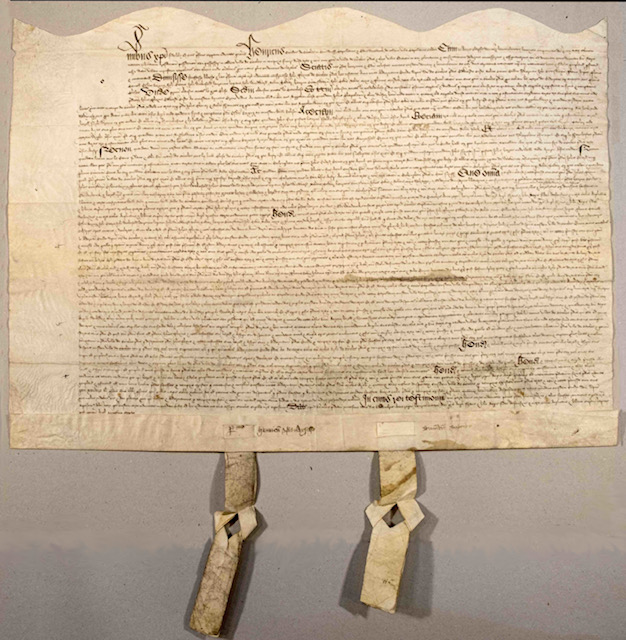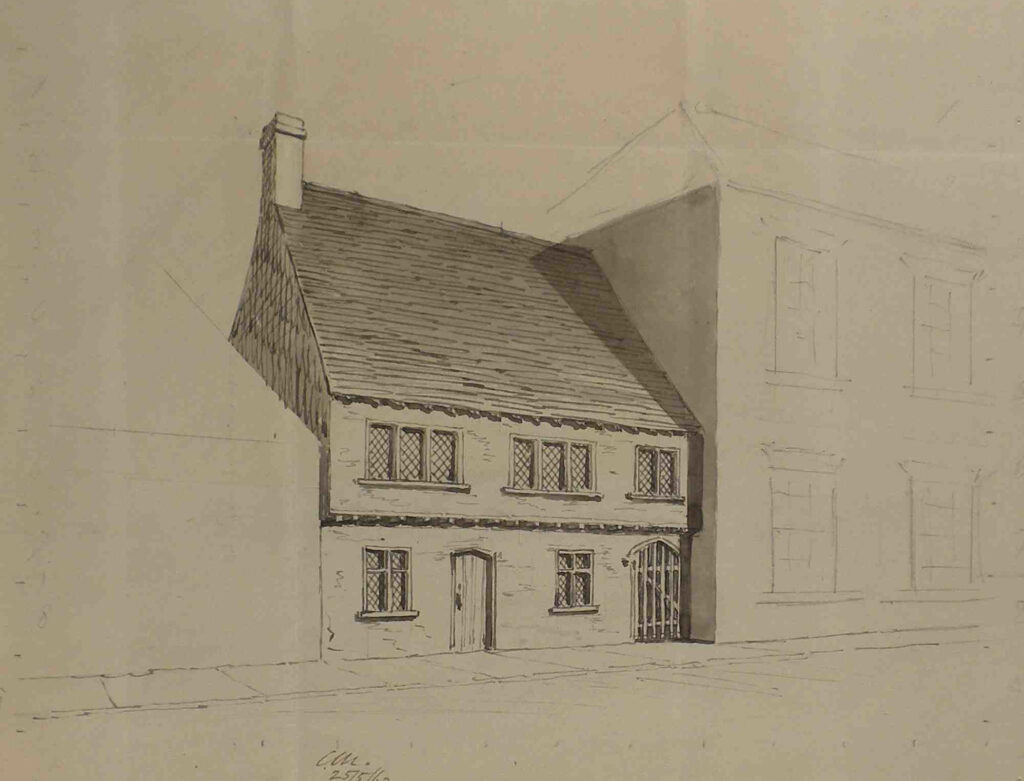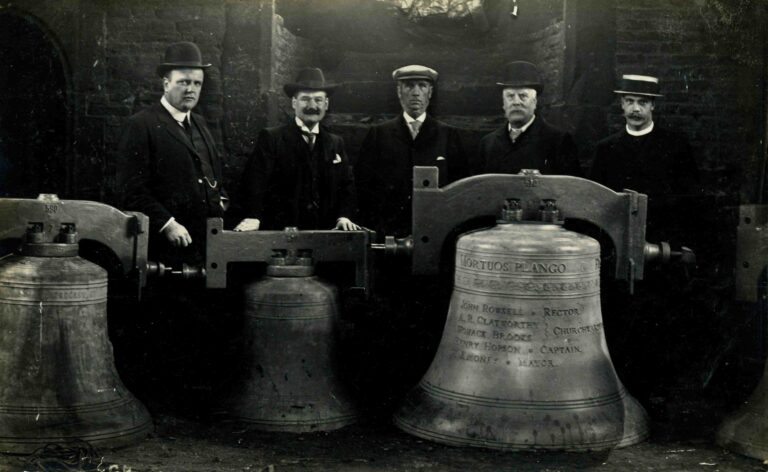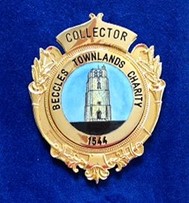
The original Trust Deed of 1544 is held within the Feoffee Records at Suffolk Records Office, Ipswich.
.
History of Beccles Townlands Charity
Beccles Townlands Charity, or The Feoffees as it is frequently known, has its origins in the fifteenth century through the religious and charitable work of the Guild of the Holy Ghost. There were seven such Guilds, attached to the Church, in Beccles at that time. During the reign of Henry VIII The Guild of the Holy Ghost broke away from the Church in order to protect its assets and became Beccles Townlands Charity. The first record of lands in our possession date from 1544 (see illustration), which is our official date of inception.
There were twelve Feoffees (Trustees) and a Collector who acted as Chairman and was responsible for the collection of rents. The first Collector was John Thorne. Records show that when he died he left £40 for the paving and stoning of Blyburgate, which at that time was the main road from Yarmouth to London.
The Charity initially held 42 acres in land and property and the rents from these provided the income for charitable and other purposes. The original Feoffees were charged with providing money for prayers to be said for their benefactors, payments to poor scholars, the choir and the Crown, with the balance used for the relief of the poor and infirm of Beccles.
Records are sparse but show that in 1636 the income was £47.94 rising to £102 in 1757 when the main expenditure was poor relief, maintenance of buildings and payments to the local militia.
History of Beccles Townlands Charity
Beccles Townlands Charity, or The Feoffees as it is frequently known, has its origins in the fifteenth century through the religious and charitable work of the Guild of the Holy Ghost. There were seven such Guilds, attached to the Church, in Beccles at that time.

The original Trust Deed of 1544 is held within the Feoffee Records at Suffolk Records Office, Ipswich.
.
History of Beccles Townlands Charity
Beccles Townlands Charity, or The Feoffees as it is frequently known, has its origins in the fifteenth century through the religious and charitable work of the Guild of the Holy Ghost. There were seven such Guilds, attached to the Church, in Beccles at that time. During the reign of Henry VIII The Guild of the Holy Ghost broke away from the Church in order to protect its assets and became Beccles Townlands Charity. The first record of lands in our possession date from 1544 (see illustration), which is our official date of inception.
There were twelve Feoffees (Trustees) and a Collector who acted as Chairman and was responsible for the collection of rents.
During the reign of Henry VIII The Guild of the Holy Ghost broke away from the Church in order to protect its assets and became Beccles Townlands Charity. The first record of lands in our possession date from 1544 (see illustration), which is our official date of inception. There were twelve Feoffees (Trustees) and a Collector who acted as Chairman and was responsible for the collection of rents.
The first Collector was John Thorne. Records show that when he died he left £40 for the paving and stoning of Blyburgate, which at that time was the main road from Yarmouth to London.
The Charity initially held 42 acres in land and property and the rents from these provided the income for charitable and other purposes. The original Feoffees were charged with providing money for prayers to be said for their benefactors, payments to poor scholars, the choir and the Crown, with the balance used for the relief of the poor and infirm of Beccles.
Records are sparse but show that in 1636 the income was £47.94 rising to £102 in 1757 when the main expenditure was poor relief, maintenance of buildings and payments to the local militia.
In the 17th century the Feoffees owned a Guildhall in Smallgate (see illustration), almshouses in Puddingmoor and a workhouse next to the Guildhall together with other buildings. In addition to maintaining their own property, provision was made towards the upkeep of the watchtower on the river, the church, the town pump, paving to Old and New Markets and repairs to the Town Cross. On 27th September 1671 when King Charles II visited Beccles, the Feoffees paid for the bells to be rung and laid 2 loads of gravel, no doubt to assist his passage through the town. The church bells were an important means of communication in olden times and the Feoffees contributed to their upkeep in addition to paying the bell ringers. As late as 2012 the Feoffees continued this tradition when they contributed to the cost of recasting the Third Bell.
In the 16th and 17th centuries Beccles was damaged by fire on seven occasions and the Feoffees made themselves responsible for primitive fire-fighting equipment. In the 18th and 19th centuries help was given towards welfare in the town, and records show blankets and coal being distributed to the needy into the twentieth century.
In more recent times a reassessment of activities was undertaken and an application made to the Charity Commissioners to formalise the Charity. In addition some of our land was sold to the local authority for the Townlands housing development which generated significant funding for other property investment and provided income to support larger projects in the town.

Sketch by Charles Malethorpe 1863 of Beccles Guildhall, owned by the Feoffees in the 17th century. Credit S W Rix, the Rix Collection, Suffolk Records Office.
.
In the 17th century the Feoffees owned a Guildhall in Smallgate (see illustration), almshouses in Puddingmoor and a workhouse next to the Guildhall together with other buildings. In addition to maintaining their own property, provision was made towards the upkeep of the watchtower on the river, the church, the town pump, paving to Old and New Markets and repairs to the Town Cross. On 27th September 1671 when King Charles II visited Beccles, the Feoffees paid for the bells to be rung and laid 2 loads of gravel, no doubt to assist his passage through the town. The church bells were an important means of communication in olden times and the Feoffees contributed to their upkeep in addition to paying the bell ringers.

Sketch by Charles Malethorpe 1863 of Beccles Guildhall, owned by the Feoffees in the 17th century. Credit S W Rix, the Rix Collection, Suffolk Records Office.
.
As late as 2012 the Feoffees continued this tradition when they contributed to the cost of recasting the Third Bell.
In the 16th and 17th centuries Beccles was damaged by fire on seven occasions and the Feoffees made themselves responsible for primitive fire-fighting equipment. In the 18th and 19th centuries help was given towards welfare in the town, and records show blankets and coal being distributed to the needy into the twentieth century.
In more recent times a reassessment of activities was undertaken and an application made to the Charity Commissioners to formalise the Charity. In addition some of our land was sold to the local authority for the Townlands housing development which generated significant funding for other property investment and provided income to support larger projects in the town.

Beccles Church Tower. Ceremony of Dedication to the rehanging of the bells 9th November 1909
.
One of the first projects receiving a financial contribution was the replacement of the Waveney Centre, which began in 1983. Later 13 Smallgate was purchased and converted into workshops and a shop for Waveney Enterprises, which provides occupation for handicapped people. A major project was the purchase of Leman House. This not only serves as the headquarters of Beccles Townands Charity but also provides accommodation for Beccles and District Museum. In due course Exchange House and property in New Market, the latter now rented to the Citizens’ Advice Bureau, were added to our portfolio of local property.
In addition to the properties mentioned above, we own some almshouses, private rental housing, agricultural land including grazing, marshes and two river frontage plots. Some properties were inherited, others purchased to hand on to future generations for the benefit of the town.
We are non-political, entirely voluntary and care about the welfare of our town and the people who live here.

Beccles Church Tower. Ceremony of Dedication to the rehanging of the bells 9th November 1909
.
One of the first projects receiving a financial contribution was the replacement of the Waveney Centre, which began in 1983. Later 13 Smallgate was purchased and converted into workshops and a shop for Waveney Enterprises, which provides occupation for handicapped people. A major project was the purchase of Leman House. This not only serves as the headquarters of Beccles Townlands Charity but also provides accommodation for Beccles and District Museum.
In due course Exchange House and property in New Market, the latter now rented to the Citizens’ Advice Bureau, were added to our portfolio of local property.
In addition to the properties mentioned above, we own some almshouses, private rental housing, agricultural land including grazing, marshes and two river frontage plots. Some properties were inherited, others purchased to hand on to future generations for the benefit of the town.
We are non-political, entirely voluntary and care about the welfare of our town and the people who live here.
